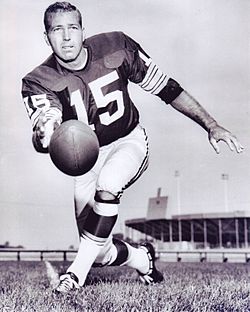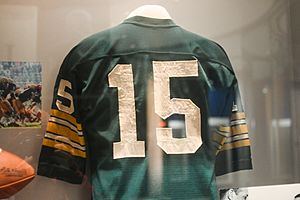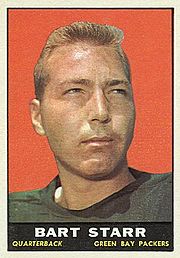Bart Starr facts for kids

Starr in the 1960s
|
|||||||||||||||
| No. 15 | |||||||||||||||
|---|---|---|---|---|---|---|---|---|---|---|---|---|---|---|---|
| Position: | Quarterback | ||||||||||||||
| Personal information | |||||||||||||||
| Born: | January 9, 1934 Montgomery, Alabama, U.S. |
||||||||||||||
| Died: | May 26, 2019 (aged 85) Birmingham, Alabama, U.S. |
||||||||||||||
| Height: | 6 ft 1 in (1.85 m) | ||||||||||||||
| Weight: | 197 lb (89 kg) | ||||||||||||||
| Career information | |||||||||||||||
| High school: | Sidney Lanier (Montgomery, Alabama) |
||||||||||||||
| College: | Alabama | ||||||||||||||
| NFL Draft: | 1956 / Round: 17 / Pick: 200 | ||||||||||||||
| Career history | |||||||||||||||
| As player: | |||||||||||||||
|
|||||||||||||||
| As coach: | |||||||||||||||
|
|||||||||||||||
| Career highlights and awards | |||||||||||||||
|
|||||||||||||||
| Career NFL statistics | |||||||||||||||
|
|||||||||||||||
| Player stats at PFR | |||||||||||||||
|
Pro Football Hall of Fame
|
|||||||||||||||
Bryan Bartlett Starr (January 9, 1934 – May 26, 2019) was a famous American football quarterback and coach. He played for the Green Bay Packers in the National Football League (NFL). Bart Starr is known for leading his team to win the first two Super Bowls. He also led the Packers to three NFL championships in a row.
Starr played college football at the University of Alabama. The Packers picked him in the 1956 NFL Draft. He played for them for 16 seasons until 1971. Later, he coached the Packers from 1975 to 1983.
Bart Starr was named the Most Valuable Player (MVP) of the first two Super Bowls. He was also chosen for the Pro Bowl four times. In 1966, he won the league MVP award. He was inducted into the Pro Football Hall of Fame in 1977. Starr has one of the highest postseason passer ratings in NFL history. He also had a great playoff record of 9 wins and 1 loss.
Contents
Early Life and High School Football
Bart Starr was born and grew up in Montgomery, Alabama. His parents were Benjamin Bryan Starr and Lula Starr. When Bart was young, his family faced some tough times.
Bart had a younger brother named Hilton. Sadly, Hilton died in 1946 from an infection after stepping on a dog bone. After this, Bart's relationship with his father became difficult. Bart was a quiet child and his father wanted him to be tougher.
Starr went to Sidney Lanier High School in Montgomery. He tried out for the football team in his second year but quit. His father gave him a choice: play football or work in the family garden. Bart chose to go back to football.
In his junior year, the main quarterback broke his leg. Bart Starr became the new starter. He led his team to a perfect season without any losses. In his senior year, Starr was named an All-State and All-American player. Many colleges offered him scholarships. He decided to play for the University of Alabama.
College Football Career
During Bart Starr's first year at Alabama, freshmen were allowed to play varsity football. Starr didn't start, but he played enough to earn a varsity letter. He played well in the Orange Bowl, completing 8 of 12 passes for 93 yards and a touchdown.
In his second year, Starr became Alabama's starting quarterback. He also played safety and punter. His punting average was second best in the nation in 1953. Alabama had a 6–2–3 record and played in the Cotton Bowl. Starr completed 59 passes for 870 yards and eight touchdowns that season.
In May 1954, Starr secretly married his high school sweetheart, Cherry Morton. Colleges often took away scholarships from married athletes back then. So, they kept their marriage a secret.
That summer, Starr hurt his back badly during a team event. He said he got hurt while punting to hide the real reason. This injury kept him from playing much in his junior year. It also meant he couldn't join the military later. The injury sometimes bothered him throughout his football career.
In 1955, Starr played very little in his senior season. Even so, the Green Bay Packers were interested in him. The Packers' personnel director, Jack Vainisi, heard good things about Starr. They believed he could succeed in the NFL. In the 17th round of the 1956 NFL Draft, the Packers picked Starr as the 200th overall player.
Starr prepared for his first NFL season by throwing footballs through a tire in his backyard. The Packers offered him $6,500 to sign, and he accepted. He also asked for $1,000 upfront.
Playing for the Green Bay Packers

Bart Starr started as a backup quarterback for the Packers in 1956. He shared playing time with other quarterbacks until 1959. That year, Vince Lombardi became the Packers' coach. Lombardi chose Starr as the main starting quarterback, and Starr kept that job.
In 1960, the Packers reached the NFL Championship Game. But they lost to the Philadelphia Eagles. This was Lombardi's only playoff loss as a head coach.
The 1961 season was Starr's first as a full-time starter. He threw for over 2,400 yards and 16 touchdowns. The Packers had an 11-3 record and returned to the NFL Championship Game. They played against the New York Giants. Starr threw for 164 yards and 3 touchdowns in a big 37-0 Packers win.
Starr and the Packers continued to be successful in 1962. They had a 13-1 record. Starr threw for a career-high 2,438 yards and 14 touchdowns. He led the league with a 62.5% completion rate. The Packers won the NFL championship again, beating the Giants 16-7. Starr was also in charge of calling plays for the offense. This showed he was a smart strategist.
In 1963, injuries kept Starr from finishing some games. The Packers didn't make it to the championship game. But Starr still threw for 1,855 yards and 15 touchdowns. By 1964, Starr became more important to the Packers' offense. Coach Lombardi brought in new receivers like Carroll Dale and Boyd Dowler. Starr had some of his best passing seasons from 1964 to 1969. In 1964, he threw for 2,144 yards, 15 touchdowns, and only 4 interceptions. He led the league with a 97.1 passer rating.
In 1965, the Packers had a 10-3-1 record. Starr threw for 2,055 yards and 16 touchdowns. He got hurt in a playoff game but his backup helped the Packers win. Starr returned for the 1965 NFL Championship Game against the Cleveland Browns. The Packers relied on their running game and won the championship.
In 1966, Starr had one of his best seasons. He threw for 2,257 yards, 14 touchdowns, and only 3 interceptions. He led the NFL in completion percentage (66.1%) and passer rating (108.3). The Packers had a great 12-2 record. Starr was named the NFL's Most Valuable Player. In the NFL Championship Game, Starr threw for 304 yards and 4 touchdowns. The Packers won 34-27. This win sent them to the first-ever Super Bowl.
Starr played well in Super Bowl I against the Kansas City Chiefs. He threw for 250 yards and two touchdowns. The Packers won 35-10. Starr was named the first-ever Super Bowl MVP.
The 1967 season was a bit tougher for Starr. He had a hand injury and threw for fewer yards and more interceptions. But the Packers' strong defense helped them finish 9-4-1. In the playoffs, Starr played well again. This led to the famous Ice Bowl game against the Dallas Cowboys. In very cold conditions, Starr made a famous play. He decided to run the ball himself for a touchdown, winning the game 21-17.

In Super Bowl II, the Packers beat the Oakland Raiders 33–14. This was Coach Lombardi's last game with the Packers. Starr won his second Super Bowl MVP award. He threw for 202 yards and a touchdown. The 1967 Packers are the only team to win three NFL titles in a row since the playoff system started in 1933.
Starr thought about retiring after Super Bowl II. But he stayed because there was no clear replacement and a new coach was coming. After Lombardi left, Starr continued to play well. He led the NFL in completion percentage and passer rating in 1968 and 1969.
In 1971, Starr had surgeries on his throwing arm. This almost caused serious problems for him. The surgeries damaged nerves in his arm, making it hard to grip the football. He played only three games in 1971, often wearing a glove. In July 1972, at age 38, Starr announced his retirement. His playing career ended with the 1971 season.
Coaching the Green Bay Packers
After retiring as a player, Bart Starr became the Packers' quarterbacks coach in 1972. The Packers won their division that year. Starr then worked as a broadcaster for two seasons.
In 1975, Starr was hired as the head coach of the Packers. He coached the team for nine years. His record as head coach was 52 wins, 76 losses, and 2 ties. It was not as successful as his playing career.
In the strike-shortened 1982 season, Starr's Packers made the playoffs for the first time in ten years. They won their first playoff game against the St. Louis Cardinals 41–16. But they lost to the Dallas Cowboys in the next round. After the 1983 season, Starr was replaced as coach.
Honors and Awards
Bart Starr received many honors for his amazing career.
- He was chosen for the NFL Pro Bowl four times.
- He was named NFL Most Valuable Player in 1966.
- He was Super Bowl MVP in 1966 and 1967.
- In 1977, he was inducted into the Pro Football Hall of Fame.
Starr is one of only six Green Bay Packers players to have his jersey number (15) retired by the team. This means no other player on the Packers can wear that number.
In 1970, President Richard Nixon spoke at an event honoring Bart Starr. He praised Starr as a great football player and leader. Nixon said Starr was "proudly the number one Packer."
In 1973, Starr received the Golden Plate Award. He was also elected to the Wisconsin Athletic Hall of Fame in 1981.
There is an NFL award named after him: the Athletes in Action/Bart Starr Award. It is given each year to an NFL player who shows great character and leadership.
Head coaching record
| Team | Year | Regular Season | Post Season | |||||||
|---|---|---|---|---|---|---|---|---|---|---|
| Won | Lost | Ties | Win % | Finish | Won | Lost | Win % | Result | ||
| GB | 1975 | 4 | 10 | 0 | .286 | 3rd in NFC Central | – | – | – | – |
| GB | 1976 | 5 | 9 | 0 | .357 | 4th in NFC Central | - | - | - | |
| GB | 1977 | 4 | 10 | 0 | .286 | 4th in NFC Central | - | - | - | |
| GB | 1978 | 8 | 7 | 1 | .531 | 2nd in NFC Central | - | - | - | |
| GB | 1979 | 5 | 11 | 0 | .313 | 4th in NFC Central | - | - | - | |
| GB | 1980 | 5 | 10 | 1 | .344 | 5th in NFC Central | - | - | - | |
| GB | 1981 | 8 | 8 | 0 | .500 | 2nd in NFC Central | - | - | - | |
| GB | 1982 | 5 | 3 | 1 | .611 | 3rd in NFC | 1 | 1 | .500 | Lost to Dallas Cowboys in NFC Second Round Game |
| 1983 | 1983 | 8 | 8 | 0 | .500 | 2nd in NFC Central | - | - | - | |
| Total | 52 | 76 | 3 | .408 | 1 | 1 | .500 | |||
NFL career statistics
| Legend | |
|---|---|
| AP NFL MVP & Super Bowl MVP | |
| Won NFL championship | |
| Won the Super Bowl | |
| Led the league | |
| Bold | Career high |
Regular season
| Year | Team | Games | Passing | Rushing | |||||||||||
|---|---|---|---|---|---|---|---|---|---|---|---|---|---|---|---|
| GP | GS | Cmp | Att | Pct | Yds | Avg | TD | Int | Rtg | Att | Yds | Avg | TD | ||
| 1956 | GB | 9 | 1 | 24 | 44 | 54.5 | 325 | 7.4 | 2 | 3 | 65.1 | 5 | 35 | 7.0 | 0 |
| 1957 | GB | 12 | 11 | 117 | 215 | 54.4 | 1,489 | 6.9 | 8 | 10 | 69.3 | 31 | 98 | 3.1 | 3 |
| 1958 | GB | 12 | 7 | 78 | 157 | 49.7 | 875 | 5.6 | 3 | 12 | 41.2 | 25 | 113 | 4.5 | 1 |
| 1959 | GB | 12 | 5 | 70 | 134 | 52.2 | 972 | 7.3 | 6 | 7 | 69.0 | 16 | 83 | 5.2 | 0 |
| 1960 | GB | 12 | 8 | 98 | 172 | 57.0 | 1,358 | 7.9 | 4 | 8 | 70.8 | 7 | 12 | 1.7 | 0 |
| 1961 | GB | 14 | 14 | 172 | 295 | 58.3 | 2,418 | 8.2 | 16 | 16 | 80.3 | 12 | 56 | 4.7 | 1 |
| 1962 | GB | 14 | 14 | 178 | 285 | 62.5 | 2,438 | 8.6 | 12 | 9 | 90.7 | 21 | 72 | 3.4 | 1 |
| 1963 | GB | 13 | 10 | 132 | 244 | 54.1 | 1,855 | 7.6 | 15 | 10 | 82.3 | 13 | 116 | 8.9 | 0 |
| 1964 | GB | 14 | 14 | 163 | 272 | 59.9 | 2,144 | 7.9 | 15 | 4 | 97.1 | 24 | 165 | 6.9 | 3 |
| 1965 | GB | 14 | 14 | 140 | 251 | 55.8 | 2,055 | 8.2 | 16 | 9 | 89.0 | 18 | 169 | 9.4 | 1 |
| 1966 | GB | 14 | 13 | 166 | 251 | 66.1 | 2,257 | 9.0 | 14 | 3 | 108.3 | 21 | 104 | 5.0 | 2 |
| 1967 | GB | 14 | 12 | 115 | 210 | 54.8 | 1,823 | 8.7 | 9 | 17 | 64.4 | 21 | 90 | 4.3 | 0 |
| 1968 | GB | 12 | 9 | 109 | 171 | 63.7 | 1,617 | 9.5 | 15 | 8 | 104.3 | 11 | 62 | 5.6 | 1 |
| 1969 | GB | 12 | 9 | 92 | 148 | 62.2 | 1,161 | 7.8 | 9 | 6 | 89.9 | 7 | 60 | 8.6 | 4 |
| 1970 | GB | 14 | 13 | 140 | 255 | 54.9 | 1,645 | 6.5 | 8 | 13 | 63.9 | 12 | 62 | 5.2 | 1 |
| 1971 | GB | 4 | 3 | 24 | 45 | 53.3 | 286 | 6.4 | 0 | 3 | 45.2 | 3 | 11 | 3.7 | 1 |
| Total | 196 | 157 | 1,808 | 3,149 | 57.4 | 24,718 | 7.8 | 152 | 138 | 80.5 | 247 | 1,308 | 5.3 | 15 | |
Personal Life and Legacy
Bart Starr and his wife Cherry were married for over 60 years. They had two sons and three granddaughters. Bart Starr was a Christian.
In 1965, Bart and Cherry Starr helped start Rawhide Boys Ranch in New London, Wisconsin. This place helps boys who are facing challenges. Starr even donated a special car he won as Super Bowl MVP to help Rawhide. He stayed involved with Rawhide Boys Ranch throughout his life.
In 1971, the Starrs also helped create the Vince Lombardi Cancer Foundation. They raised money for cancer research and care, honoring his former coach, Vince Lombardi. They later started the Starr Children's Fund to support research for childhood cancer.
In his later years, Starr faced several health challenges. He had strokes and other issues. In 2015, his family shared that he was getting special medical treatment. He was able to attend a ceremony in 2015 when another Packers quarterback, Brett Favre, had his jersey number retired. He also attended a reunion of the Ice Bowl Packers in 2017.
Bart Starr passed away on May 26, 2019, at the age of 85. He died in Birmingham, Alabama, after a period of declining health.
See also
 In Spanish: Bart Starr para niños
In Spanish: Bart Starr para niños


